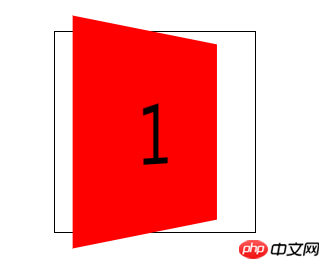在css二维的世界里,我们可以对元素设置宽高、位置、旋转、背景等等。在css三维世界里,扩展出了一个z轴,这个z轴垂直于屏幕并指向外面。下面这篇文章主要给大家介绍了利用HTML5+CSS3实现3D转换效果的相关资料,需要的朋友可以参考,希望能帮助到大家。
首先,我们来了解一下3d的坐标系,x轴在屏幕上为水平方向,y轴为垂直方向,而z轴为垂直于屏幕的方向。
不理解的话可以参考定位属性的z-index属性,那个在某种意义上就是让元素在z轴的移动。
在2d转换模块中我们研究了rotateX()和rotateY()方法,就是绕x轴和y轴旋转,这其实就是3d模块的一种表现,当然要看到近大远小的3d效果,还需要在父元素上添加透视属性:transform:perspective(500px);值为透视点到元素的距离,具体概念请看美术透视教学。。。。
多说无益,上代码:
Titlep{
width: 200px;
height: 200px;
margin: 0 auto;
}
.p1{
margin-top: 100px;
transform:perspective(500px) rotatey(0deg);
position: relative;
border:1px solid #000000;
background-color: #ff0000;
}
.p1 p{
transform:rotatey(45deg);
position: absolute;
font-size: 80px;
line-height: 200px;
text-align: center;
top: 0;
left: 0;
}
1
效果图:

但是,你会发现当父元素转到90度的时候元素消失了,这就说明元素是没有厚度的。说明元素虽然具有了近大远小的透视属性,但本质上仍是2d的。
这是你需要添加transform-style:preserve-3d;样式来让元素在3d空间中转换。这样,元素就处在了3维的空间里,当父元素旋转90度,仍能看到里面的子元素。
示例代码:
Titlep{
width: 200px;
height: 200px;
margin: 0 auto;
}
.p1{
margin-top: 100px;
transform:perspective(500px) rotatey(0deg);
transform-style:preserve-3d;
position: relative;
border:1px solid #000000;
}
.p1 p{
background-color: #ff0000;
transform:rotatey(45deg);
position: absolute;
font-size: 80px;
line-height: 200px;
text-align: center;
top: 0;
left: 0;
}
1
效果图:

上面,我们对3d转换模块有了一个初步的了解,下面我们一起做一个正方体,来整理一下3d模块的知识。
一步步来做着写太过麻烦,我就将过程写在代码的注释里,小伙伴们请见谅。
代码:
转换模块-正方体*{
margin: 0;
padding: 0;
/*去除默认边距*/
}
ul{
width: 200px;
height: 200px;
border: 1px solid #000;
box-sizing: border-box;
margin: 100px auto;
position: relative;
/*修改基本样式*/
transform: rotateY(45deg) rotateX(45deg);
/*旋转看看效果*/
transform-style: preserve-3d;
/*将父元素设置为3d空间*/
}
ul li{
list-style: none;
width: 200px;
height: 200px;
font-size: 60px;
text-align: center;
line-height: 200px;
position: absolute;
left: 0;
top: 0;
/*修改基本样式*/
}
ul li:nth-child(1){
background-color: red;
transform: translateX(-100px) rotateY(90deg);
/*将第一个l向左移动100像素,然后绕y轴旋转90度,形成左边的面*/
}
ul li:nth-child(2){
background-color: green;
transform: translateX(100px) rotateY(90deg);
/*将第一个2向右移动100像素,然后绕y轴旋转90度*,形成右边的面*/
}
ul li:nth-child(3){
background-color: blue;
transform: translateY(-100px) rotateX(90deg);
/*将第一个3向上移动100像素,然后绕x轴旋转90度,形成上面的面*/
}
ul li:nth-child(4){
background-color: yellow;
transform: translateY(100px) rotateX(90deg);
/*将第一个4向下移动100像素,然后绕x轴旋转90度*/
}
ul li:nth-child(5){
background-color: purple;
transform: translateZ(-100px);
/*将第一个5向后移动100像素,形成后面的面*/
}
ul li:nth-child(6){
background-color: pink;
transform: translateZ(100px);
/*将第一个l向前移动100像素,形成前面的面*/
}
- 1
- 2
- 3
- 4
- 5
- 6
效果图:

这个方法比较好理解,理解了之后请看下一个。
代码在下面:
Titlep{
width: 200px;
height: 200px;
margin: 0 auto;
/*修改基本样式*/
}
.p1{
margin-top: 100px;
transform: perspective(400px) rotatex(0deg) rotatey(0deg);
/*拥有近大远小透视效果*/
transform-style: preserve-3d;
/*设置为3d空间*/
position: relative;
border:1px solid #000000;
animation: xuanzhuan 5s cubic-bezier(0.0,0.0,0.0,0.0) infinite forwards;
/*旋转动画*/
}
.p1 p{
position: absolute;
font-size: 80px;
line-height: 200px;
text-align: center;
top: 0;
left: 0;
/*内部样式*/
}
.p1_1{
transform: translatez(100px);
background-color: red;
/*向前移动100像素,作为最前面的面*/
}
.p1_2{
transform: rotatex(90deg) translatez(100px);
background-color:green;
/*绕x轴旋转90度,在z轴正方向移动100像素,作为上面的面*/
/*注:旋转时坐标系会跟着一起旋转,z轴原来是垂直屏幕向外的,绕x轴旋转90度以后就是在屏幕上向上的方向*/
}
.p1_3{
transform: rotatex(180deg) translatez(100px);
background-color: blue;
/*绕x轴旋转180度,这时z轴垂直屏幕向内,在z轴正方向移动100像素,作为后面的面*/
}
.p1_4{
transform: rotatex(270deg) translatez(100px);
background-color: purple;
/*绕x轴旋转270度,这时z轴向下,在z轴正方向移动100像素,作为下面的面*/
}
.p1_5{
transform: rotatey(90deg) translatez(100px);
background-color: pink;
/*绕y轴旋转90度,这时z轴向右,在z轴正方向移动100像素,作为右面的面*/
}
.p1_6{
transform: rotatey(270deg) translatez(100px);
background-color: yellow;
/*绕y轴旋转90度,这时z轴向左,在z轴正方向移动100像素,作为左面的面*/
}
@-webkit-keyframes xuanzhuan{
from{
transform:perspective(400px) rotatex(0deg);
}
to{
transform:perspective(400px) rotatex(360deg);
}
}
.p1:hover{
transform: perspective(400px) scale(1.5);
animation: xuanzhuan 5s cubic-bezier(0.0,0.0,0.0,0.0) infinite paused forwards;
/*有hover事件是动画暂停*/
}
1
2
3
4
5
6
效果图:

这种写法只要理解了,写起来会更加的方便,而且不不用去考虑转换的角度不对会导致内容是反的,所以推荐这一种写法。当然这种写法在x轴和y轴一起旋转是也会造成内容的反转。
相关推荐:




















 381
381











 被折叠的 条评论
为什么被折叠?
被折叠的 条评论
为什么被折叠?








